The religion of the Mass "Sun
Worship"
 DO PRIESTS HAVE
DO PRIESTS HAVE power to
change the elements of bread and wine into the flesh and blood of
Christ during the Mass ritual? Is this belief founded on the
Scriptures?
The Roman
Catholic position is summed up in these words: "In the celebration
of the Holy Mass, the bread and wine are changed into the body and
blood of Christ. It is called transubstantiation, for in the
Sacrament of the Eucharist the substance of bread and wine do not
remain, but the entire substance of bread is changed into the body
of Christ, and the entire substance of wine is changed into his
blood, the species or outward semblance of bread and wine alone
remaining."
Support for
this belief is sought in the words of Jesus when he said of the
bread he had blessed: "Take eat; this is my body" and of the cup,
"Drink ye all of it; for this is my blood" (Matt. 26:26-28).
But forcing a literal meaning on these words creates numerous
problems of interpretation and tends to overlook the fact that the
Bible commonly uses figurative expressions.
When some of
David's men risked their lives to bring him water from Bethlehem,
he refused it, saying, "Is not this the blood of men who went in
Jeopardy of their lives?" (2 Sam. 23:17). The Bible speaks
of Jesus as a "door," "vine," and "rock" (John 10:9; 15:5; I Cor.
10:4). All recognize these statements are figurative.
We believe that such is also true of Christ's statement "this is
my body...this is my blood."
The bread and wine are
symbols of his body and blood. This does not detract
from the reality of his presence within an assembly of believers,
for he promised, "Where two or three are gathered together in my
name, there am I in the midst of them'" (Matt. 18:20). To reject
the idea that he becomes literally present in pieces of bread or
inside a cup of wine is not to reject that he is present
spiritually among believers! Interesting note, before 1776
Protestant England called this kind of practice a
superstitious and
idolatrous religion. It
was written right into the government Royal Declaration?
Click here for
more information.
After Jesus
"blessed" the elements, they were not changed into his literal
flesh and blood, for he (literally) was still there. He had
not vanished away to appear in the form of bread and wine. After
he had blessed the cup, he still called it "the fruit of the
vine," not literal blood (Matt. 26:29). since Jesus drank from the
cup also, did he drink his own blood? If the wine became
actual blood, to drink it would have been forbidden by the Bible
(Deut. 12:16; Acts 15:20).
There is no
evidence that any change comes to the elements through the Romish
ritual. They have the same taste, color, smell, weight, and
dimensions. The bread still looks like bread, tastes like
bread, smells like bread, and feels like bread. But in the
Roman Catholic mind, it is the flesh of God. The wine still
looks like wine, tastes like wine, smells like wine, and if one
drank enough, it would make him drunk like wine! But this is
believed to be the blood of God.
When the priest
blesses the bread and wine, he says the Latin words, Hoc est
corpus meus. In view of the fact that no change
takes place "hocus--pocus"
we can understand how the expression originated with these words.
The Council of
Trent proclaimed that the belief in transubstantiation is
essential to salvation and pronounced curses on any who would deny
it. The Council ordered pastors to explain that not only did the
elements of the Mass contain flesh, bones, and nerves as a part of
Christ, "but also a WHOLE CHRIST." The Catholic Encyclopedia
says, "The dogma of the totality of the Real Presence means that
in each individual species the WHOLE CHRIST, flesh and blood, body
and soul, Divinity and humanity, is really present."
The piece of
bread having become "Christ," it is believed that in offering it
up, the priest sacrifices Christ. A curse was pronounced by
the Council of Trent on any who believed otherwise: "If any one
saith that in the Mass a true and proper sacrifice is not offered
to God...let him be anathema." In Catholic belief, this
"sacrifice" is a renewal of the sacrifice of the cross:
"Christ...commanded that his bloody sacrifice on the Cross should
be daily renewed by an un--bloody sacrifice of his Body and Blood
in the Mass under the simple elements of bread and wine."
Because the elements are changed into Christ, he "is present in
our churches not only in a spiritual manner, but really, truly,
and substantially as the victim of a sacrifice." Though the
ritual has been carried out millions of times, attempts are made
to explain that it is the same sacrifice as Calvary because the
victim in each case is Jesus Christ.

The very idea of Christ--"flesh and
blood, body and soul, Divinity and humanity"--being offered
repeatedly as a "renewal" of the sacrifice of the cross, stands in
sharp contrast to the words of Jesus on the cross: "It is;
finished" (John 19:30). The Old Testament sacrifices had to
be continually offered because none of them was the perfect
sacrifice. But now "we are sanctified through the offering
of the body of Jesus Christ ONCE for all. For every priest
standeth daily ministering and offering oftentimes the same
sacrifices, which can never take away sins: but this man (Christ),
after he had offered ONE sacrifice for sins...forever, sat down on
the right hand of God...for by ONE offering he perfected forever
them that are sanctified" (Heb. 10:10- 14).
Catholic
doctrine says the sacrifice of Christ on the cross should "be
daily renewed," but the New Testament sets the idea of "daily
sacrifices" in contrast to the ONE sacrifice of Christ. He
was not to be offered often, for "as it is appointed unto men once
to die...so Christ was ONCE offered to bear the sins of many"
(Heb. 9:25-28). In view of this, those who believe the
sacrifice of the cross should be continually renewed in the Mass,
in a sense, "crucify to themselves the Son of God afresh, and put
him to an open shame" (Heb. 6:6).
After the
bread has been changed into "Christ' by the priest, it ts placed
on a monstrance in the
center of a sunburst design. Before the monstrance Catholics bow
and worship the little wafer as God! This practice is
similar to the practices of heathen tribes that worship fetishes.
Is it
Scriptural? Notice what The Catholic Encyclopedia says: "In the
absence of Scriptural proof, the Church finds a warrant for, and a
propriety in, rendering Divine worship to the Blessed Sacrament in
the most ancient and constant tradition...This reasoning brings to
mind the words of Jesus, "...making the word of God of none
effect through your tradition" (Mark 7:13).
The idea of
transubstantiation was not without its problems. Tertullian
tells us that priests took great care that no crumb should
fall--lest the body of Jesus be hurt! Even a crumb was believed to
contain a whole Christ. In the Middle Ages, there were serious
discussions as to what should be done if a person were to vomit
after receiving communion or if a dog or mouse were by chance to
eat God's body! At the Council of Constance, it was argued
whether a man who spilled some of the blood of Christ on his beard
should have his beard burned, or if the beard and the man should
be destroyed by burning. It is admitted on all sides that
numerous strange doctrines accompanied the idea of
transubstantiation.
In the New
Testament church it is evident that Christians partook of both the
bread and the fruit of the vine as emblems of Christ's death ( I
Cor. 11:28). This The Catholic Encyclopedia admits:
"It may be stated as a general fact, that down to the twelfth
century, in the West as well as in the East, public Communion in
the churches was ordinarily administered and received under both
kinds," a fact "clearly beyond dispute." But, after all
these centuries, the Roman Catholic Church began to hold back the
cup from the people, serving them only the bread. The priest drank
the wine. One argument was that someone might spill the
blood of Christ. But was it not possible that the early
disciples could have spilled the cup? Christ did not withhold it
from them.
Serving only
half of what Jesus had instituted called for certain
"explanations." It was explained that "communion under one
kind," as it was called, was just as valid as taking both.
The people would not be deprived of any "grace necessary for
salvation" and that "Christ is really present and is received
whole and entire, body and blood, soul and Divinity, under either
species alone....Holy mother the Church....has approved the custom
of communicating under one kind....Not only, therefore, is
Communion under both kinds not obligatory on the faithful, but the
chalice is strictly forbidden by ecclesiastical law to any but the
celebrating priest"! After many centuries, this law has now
been relaxed. Some Catholics are allowed to partake of both
bread and cup, but customs vary from place to place.
Did the idea of
transubstantiation begin with Christ? The historian Durant
tells us that the belief in transubstantiation as practiced in the
Roman Catholic Church, is "one of the oldest ceremonies of
primitive religion."
In the
scholarly work Hastings Encyclopedia of Religion and Ethnics, many
pages are devoted to an article "Eating the god." In these
pages, abundant evidence is given of transubstantiation rites
among many nations, tribes, and religions.
Such rites were
known in sun worship Rome
also, as evidenced from Cicero's rhetorical question about the
corn of Ceres and the wine of Bacchus. "Mithraism had a
Eucharist, but the idea of a sacred banquet is as old as the human
race and existed at all ages and amongst all peoples," admits The
Catholic Encyclopedia.
In Egypt, a
cake was consecrated by a priest and was supposed to become the
flesh of Osiris. This was then eaten and wine was taken as a
part of the rite. Even in Mexico and Central America, among
those who had never heard of Christ, the belief in eating the
flesh of a god was found. When Catholic missionaries first
landed there, they were surprised "when they witnessed a religious
rite which reminded them of communion,...an image made of
flour...after consecration by priests, was distributed among the
people who ate it...declaring it was the flesh of the deity."
Hislop suggests
that the idea of eating the flesh of a god was of cannibalistic
inception. Since heathen priests ate a portion of all
sacrifices, in cases of human sacrifice, priests of Baal were
required to eat human flesh. Thus "Cahna-Bal," that is,
"priest of Baal," has provided the basis for our modern word
"cannibal."
During! Mass,
Catholics in good standing come forward and kneel before the
priest who places a piece of bread--"Christ"--in their mouths.
This is called a "host," from a Latin word originally meaning
"victim" or "sacrifice." In Catholic belief, the host "has
been the object of a great many miracles," including the bread
being turned to stone and hosts which have bled and continued to
bleed.
Hosts are made
in a
round shape, this
form first being mentioned by St. Epiphanius in the fourth
century. But when Jesus instituted the

memorial supper, he simply took bread and brake
it. Bread does not break into round pieces! Breaking
the bread actually represents the body of Jesus which was broken
for us by the cruel beatings and stripes. But this symbolism is
not carried out by serving a round, disk-shaped wafer completely
whole.
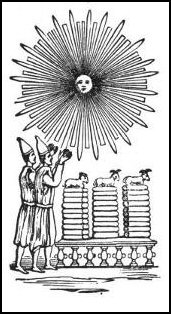
If the use of a round wafer is without
Scriptural basis, is it possible that we are faced with another
example of
sun worship influence?
Hislop says, "The 'round' wafer, whose 'roundness' is so important
an element in the Romish Mystery, is only another symbol of Baal,
or the sun."
We know that round cakes were used in the
ancient mysteries of Egypt. "The thin, round cake occurs on
all altars." In the mystery religion of Mithralsm, the
higher initiates received a small round cake or wafer of
unleavened bread which symbolized the solar disk as did their
round tonsure.
In 1854, an
ancient temple was discovered in Egypt with inscriptions that show
little round cakes on an altar. Above the altar is a large
image of the sun. A
similar sun-symbol was
used above the altar of a temple near the town of Babain, in upper
Egypt where there is a representation of the sun, before which two priests
are shown worshiping. (picture left.)
This use of
the
sun-image above the
"altar" was not limited to Egypt. Even in
far away Peru, this same image
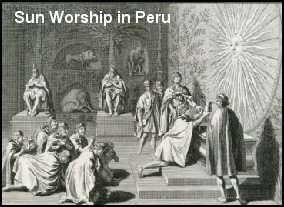
was
known and worshiped. If one compares the
sun image before which the
heathen bowed with the monstrance
sun image--in which the host is placed as a "
sun" and before which
Catholics bow--a striking similarity will immediately be
seen.
We see they are practicing Sun Worship.

Even among the Israelites, when they
fell into Baal worship,
sun--images
were set up above the altars! But during the reign of
Josiah, these images were torn down: "And they brake down the
altars of Baalim in his presence; and the images (margin,
sun-images) that were on
high above them" (2 Chron. 34:41).
The
accompanying old woodcut illustrates(photo left) some of the
strange images that idolatrous Jews worshiped, including sun--images at the top of
columns.
The photograph
on the left. Shows the altar of St. Peter's and ninety--five
foot canopy which is supported by
four columns, twisted and sightly covered by
branches. At the top of the columns--"on high above" the
most important altar in Catholicism--are decorative
sun images. High on the wall,
as the photograph also shows, is a huge and elaborate
golden sunburst image which,
from the entrance of the church, also
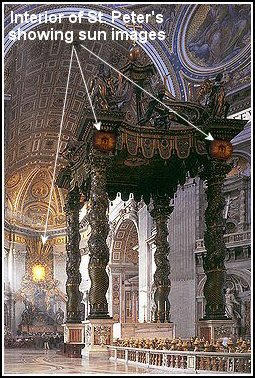
appears "above" the altar. A large
sun--image also appears above
the altar of the Church of the Gesu, Rome, and hundreds of
others. Interestingly enough, the great temple at Babylon
also featured a golden
sun-image.
Sometimes the
circular
sun--image is a
stained glass window above the altar or, as is very common, above
the entrance of churches. Some of these central circular
windows are beautifully decorated. Some are surrounded with
sun rays. In Babylon
there were temples with images of the
sun--god to face the
rising sun placed above the entries. An
early Babylonian temple built by king Gudea featured
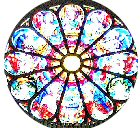
such an emblem of the
sun-god over the
entrance. It was a custom for Egyptian builders to place a
solar disk (sometimes with wings or other emblems) over the
entrance of their temples to honor the
sun--god and drive away evil spirits. We are
not suggesting, of course, that the round designs in use today
convey the meanings they once did to those who went to heathen
temples. Nevertheless, the similarity in design seems
curious.
The circular
window that has been so commonly used above the entrances of
churches is sometimes called a "wheel" window. The wheel
design, as the wheel of a chariot, was believed by some of the
ancients to also be a sun--symbol.
They thought of the sun
as a great chariot driven by the sun-god
who made his trip across the heavens each day and passed through
the underworld at night. When the Israelites mixed the
religion of Baal into their worship, they had "chariots of the sun"--chariots
dedicated to the sun--god
(2 Kings 23:4-11). An image in the form of a chariot wheel is placed
over the famous statue of Peter in St. Peter's. A tablet now ln a
British museum shows one of the Babylonian kings restoring a symbol of the sun-god in the temple of
Bel. The symbol is an eight pointed cross, like a spoked
wheel. The Babylonian solar
wheel (left) has been inked with occultism and
astrology. A similar design marks the pavement of the
circular court before St. Peter's church (below).

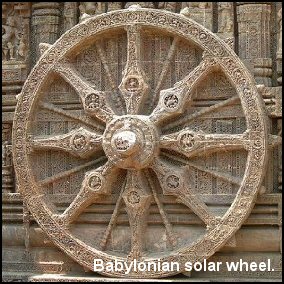
Romish pictures of Mary and the saints
feature a circular
sun-symbol
disk
around their heads. The Roman tonsure is round.
Round images are seen above the altars and entrances. The
monstrance in which the round host is placed often features a
sun-burst design. All of
these uses of
sun symbols
may seem quite insignificant. But when the overall picture
is seen, each provides a clue to help
Expose Mystery Babylon ". (Sun (Baal) Worship)
When Jesus
instituted the memorial supper, it was at night. It was not
at breakfast time, or at lunch time. The first Christians
partook of the Lord's supper at night, following the example of
Christ and the types of the Old Testament. But later, the
Lord's supper came to be observed at a morning meeting. To what
extent this may have been influenced by Mithraism, we cannot
say. We do know that the Mithraic rites were observed early
in the morning, being associated with the
sun and dawn. For
whatever reason, it is now a common custom among both Catholic and
Protestant
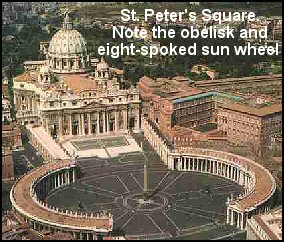
churches to take the Lord's "supper" in the morning.
A factor that
may have encouraged the early morning Mass within the Catholic
Church was the idea that a person should be fasting before
receiving communion. Obviously early morning was an easier
time to meet this requirement! But to require such fasting
cannot be solidly built on scripture, for Jesus had just eaten
when he instituted the memorial supper!
On the other
hand, those who sought initiation in the Eleusinian mysteries were
first asked: "Are you fasting?" If their answer was
negative, initiation was denied. Fasting itself is, of
course, Biblical. But true fasting must come from the heart
and not merely because of a man--made rule. Of such, God
says, "When they fast, I will not hear their cry" (Jer.
14:12). The Pharisees were strict about fasting on certain
days, but neglected the weightier matters of the law (Matt. 6:16).
Paul warned about certain commandments to "abstain from meats
(foods)" as being a mark of apostasy (1 Tim.4:3).
In commenting
on the Mass and its elaborate ritualism, Romanism and the Gospel
says: "It is a spectacle of gorgeous magnificence--lights, colors,
vestments, music, incense, and what has a strange psychological
effect, a number of drilled officiants performing a stately ritual
in entire independence of the worshipers. These are indeed
spectators, not participants, spectators like those who were
present at a performance of the ancient mystery cults.'
A noted work on
Catholicism summarizes the mechanical performance made by the
priest during Mass: "He makes the sign of the cross sixteen times;
turns toward the congregation six times; lifts his eyes to heaven
eleven times; kisses the altar eight times; folds his hands four
times; strikes his breast ten times; bows his head twenty-one
times genuflects eight times bows his shoulders seven times;
blesses the altar with the sign of the cross thirty times; lays
his hands flat on the altar twenty-nine times; prays secretly
eleven times; prays aloud thirteen times: takes the bread and wine
and turns it into the body and blood of Christ: covers and
uncovers the chalice ten times; goes to and fro twenty times."
Adding to this complicated ritualism is the use of highly colored
robes, candles, bells, incense, music, and the showy pageantry for
which Romanlsm is known. What a contrast to the simple
memorial supper instituted by Christ!
“Signs and symbols rule the Sun Worship world, not
words nor laws.”
www.granddesignexposed.com
 DO PRIESTS HAVE power to
change the elements of bread and wine into the flesh and blood of
Christ during the Mass ritual? Is this belief founded on the
Scriptures?
DO PRIESTS HAVE power to
change the elements of bread and wine into the flesh and blood of
Christ during the Mass ritual? Is this belief founded on the
Scriptures? DO PRIESTS HAVE power to
change the elements of bread and wine into the flesh and blood of
Christ during the Mass ritual? Is this belief founded on the
Scriptures?
DO PRIESTS HAVE power to
change the elements of bread and wine into the flesh and blood of
Christ during the Mass ritual? Is this belief founded on the
Scriptures? The very idea of Christ--"flesh and
blood, body and soul, Divinity and humanity"--being offered
repeatedly as a "renewal" of the sacrifice of the cross, stands in
sharp contrast to the words of Jesus on the cross: "It is;
finished" (John 19:30). The Old Testament sacrifices had to
be continually offered because none of them was the perfect
sacrifice. But now "we are sanctified through the offering
of the body of Jesus Christ ONCE for all. For every priest
standeth daily ministering and offering oftentimes the same
sacrifices, which can never take away sins: but this man (Christ),
after he had offered ONE sacrifice for sins...forever, sat down on
the right hand of God...for by ONE offering he perfected forever
them that are sanctified" (Heb. 10:10- 14).
The very idea of Christ--"flesh and
blood, body and soul, Divinity and humanity"--being offered
repeatedly as a "renewal" of the sacrifice of the cross, stands in
sharp contrast to the words of Jesus on the cross: "It is;
finished" (John 19:30). The Old Testament sacrifices had to
be continually offered because none of them was the perfect
sacrifice. But now "we are sanctified through the offering
of the body of Jesus Christ ONCE for all. For every priest
standeth daily ministering and offering oftentimes the same
sacrifices, which can never take away sins: but this man (Christ),
after he had offered ONE sacrifice for sins...forever, sat down on
the right hand of God...for by ONE offering he perfected forever
them that are sanctified" (Heb. 10:10- 14). memorial supper, he simply took bread and brake
it. Bread does not break into round pieces! Breaking
the bread actually represents the body of Jesus which was broken
for us by the cruel beatings and stripes. But this symbolism is
not carried out by serving a round, disk-shaped wafer completely
whole.
memorial supper, he simply took bread and brake
it. Bread does not break into round pieces! Breaking
the bread actually represents the body of Jesus which was broken
for us by the cruel beatings and stripes. But this symbolism is
not carried out by serving a round, disk-shaped wafer completely
whole. If the use of a round wafer is without
Scriptural basis, is it possible that we are faced with another
example of sun worship influence?
Hislop says, "The 'round' wafer, whose 'roundness' is so important
an element in the Romish Mystery, is only another symbol of Baal,
or the sun."
If the use of a round wafer is without
Scriptural basis, is it possible that we are faced with another
example of sun worship influence?
Hislop says, "The 'round' wafer, whose 'roundness' is so important
an element in the Romish Mystery, is only another symbol of Baal,
or the sun." was
known and worshiped. If one compares the sun image before which the
heathen bowed with the monstrance sun image--in which the host is placed as a "sun" and before which
Catholics bow--a striking similarity will immediately be
seen. We see they are practicing Sun Worship.
was
known and worshiped. If one compares the sun image before which the
heathen bowed with the monstrance sun image--in which the host is placed as a "sun" and before which
Catholics bow--a striking similarity will immediately be
seen. We see they are practicing Sun Worship. Even among the Israelites, when they
fell into Baal worship, sun--images
were set up above the altars! But during the reign of
Josiah, these images were torn down: "And they brake down the
altars of Baalim in his presence; and the images (margin, sun-images) that were on
high above them" (2 Chron. 34:41).
Even among the Israelites, when they
fell into Baal worship, sun--images
were set up above the altars! But during the reign of
Josiah, these images were torn down: "And they brake down the
altars of Baalim in his presence; and the images (margin, sun-images) that were on
high above them" (2 Chron. 34:41).  appears "above" the altar. A large sun--image also appears above
the altar of the Church of the Gesu, Rome, and hundreds of
others. Interestingly enough, the great temple at Babylon
also featured a golden sun-image.
appears "above" the altar. A large sun--image also appears above
the altar of the Church of the Gesu, Rome, and hundreds of
others. Interestingly enough, the great temple at Babylon
also featured a golden sun-image. such an emblem of the sun-god over the
entrance. It was a custom for Egyptian builders to place a
solar disk (sometimes with wings or other emblems) over the
entrance of their temples to honor the sun--god and drive away evil spirits. We are
not suggesting, of course, that the round designs in use today
convey the meanings they once did to those who went to heathen
temples. Nevertheless, the similarity in design seems
curious.
such an emblem of the sun-god over the
entrance. It was a custom for Egyptian builders to place a
solar disk (sometimes with wings or other emblems) over the
entrance of their temples to honor the sun--god and drive away evil spirits. We are
not suggesting, of course, that the round designs in use today
convey the meanings they once did to those who went to heathen
temples. Nevertheless, the similarity in design seems
curious.
 Romish pictures of Mary and the saints
feature a circular sun-symbol
disk
around their heads. The Roman tonsure is round.
Round images are seen above the altars and entrances. The
monstrance in which the round host is placed often features a sun-burst design. All of
these uses of sun symbols
may seem quite insignificant. But when the overall picture
is seen, each provides a clue to help Expose Mystery Babylon ". (Sun (Baal) Worship)
Romish pictures of Mary and the saints
feature a circular sun-symbol
disk
around their heads. The Roman tonsure is round.
Round images are seen above the altars and entrances. The
monstrance in which the round host is placed often features a sun-burst design. All of
these uses of sun symbols
may seem quite insignificant. But when the overall picture
is seen, each provides a clue to help Expose Mystery Babylon ". (Sun (Baal) Worship) churches to take the Lord's "supper" in the morning.
churches to take the Lord's "supper" in the morning.